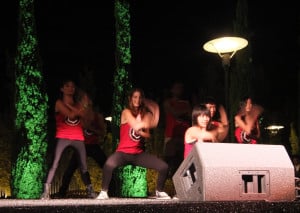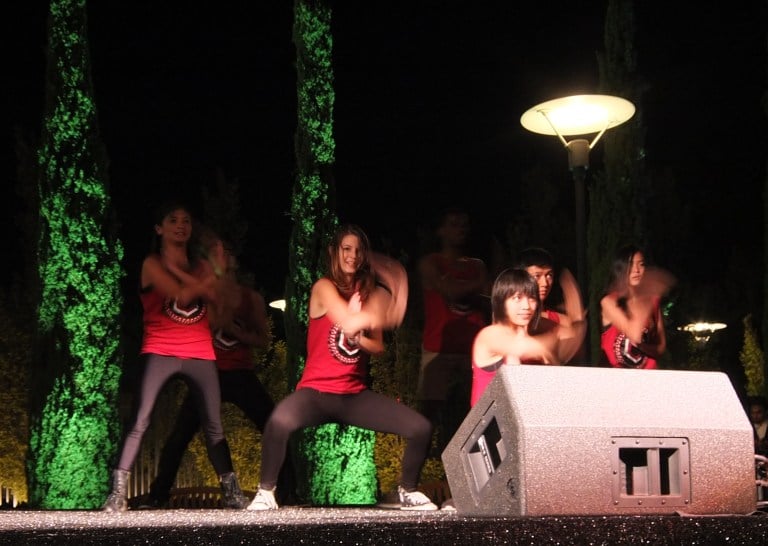
For sophomore Crystal Tjoa, high school dances used to create a lot of anxiety because she thought she wasn’t very good.
“I would mostly just jump around and do the sprinkler,” she said. “I never actually danced until I got to Stanford and to [Common Origins].”
Common Origins (CO), a hip-hop dance group on campus, encourages an open and welcoming environment for new and inexperienced dancers by not requiring an audition before becoming a member. CO is the only one of the three main hip-hop groups on campus – the others are Alliance Streetdance and Dv8 – that take all comers.
“To me, Common Origins offers a lot of freedom to push yourself,” Tjoa said. “We try and make it possible for you… There are a lot of different ranges of experience, and it’s a very supporting community.”
“I’m glad they join solely because they think dancing is fun, because that is at the heart of what CO is,” added Aloysius Makalinao ’16, co-president this year. “We’re accommodating to our people first and our performance second.”
Open auditions
According to Vienna Harvey ’16, a choreographer this year, when CO was first founded five years ago, it was intended as a place for people to express themselves through dance regardless of their skill level. It was founded by a group of friends who were noticing a lack of dance group opportunities for people who couldn’t make it through the Dv8 or Alliance auditions but still wanted a place to dance.
“CO is making dance accessible for everyone,” added Emmanuel Assa ’17. “Maybe you don’t understand dance because you’ve never danced, but when you get into the position of learning choreography [with CO] and you understand more of what dance is when you see other people dance, then you get more intrigued by it.”
Makalinao added that out of the 40 or 50 total members in CO at any given time, about 30 of those could be completely new dancers to the group. According to Harvey, this can create a high turnover rate of new members, which can lead to difficulties for the group.
“We have to start out every quarter with a whole new set of people who have never danced and bring them up to the level of performing before 700 people in 10 weeks,” Harvey said. “It’s especially difficult for people who have been there for a while, who may not want to take a step back that much [to work with a new group each time]. But I think CO takes pride in [welcoming new members].”
Makalinao agreed, noting the group’s democratic nature as a key part of the welcoming atmosphere.
“With some other hip hop groups, when you join a new one, you have less to say, but with CO it’s okay to point out that the president is wrong,” Makalinao said. “There are not any barriers that make any one person any better than anyone else [on the team].”
Passion for dance
Given the lack of auditions for joining CO, many of its members had no prior dancing experience before, like Tjoa, but found themselves in a comfortable place where they could learn.
“I’m a choreographer this year, but I didn’t plan to audition,” Tjoa said. “I was encouraged by other people in the group to really push myself and try it out.”
Other members, however, have been dancing hip hop for years. Assa joined a break dancing team after transferring to a new high school after his sophomore year.
“The first thing that I looked for when I got to Stanford was a student group [for hip hop dancers],” he said. “I tried out for Alliance but didn’t get it, so I went to CO.”
He added that he did join CO in order to improve his own abilities and that even though the group can change its composition and skill level each quarter, he did feel like he was given the opportunity to get better.
“A lot of the choreography we do and the teachers we bring in are fairly advanced, so you do get real dance experience,” he said. “There’s no little-kid choreography with CO.”
Harvey added that she had been dancing since she was 4 or 5 years old, mostly ballet and other styles as she got older, such as trapeze and aerial trapeze.
“When I got to Stanford, I wanted to try a different style and I thought hip hop sounded fun,” she said. “But I was too intimidated to try to join the other groups, so once I heard that anyone who wants to join [CO] is welcome, I decided to try.”
Dance at other schools
According to Makalinao, CO and other Stanford dance groups differ greatly from groups at other schools because the Stanford groups don’t enter competitions.
“At the Berkeley competitive hip-hop team, they practice every day and it’s basically a five-unit class,” he said. “I think the hip-hop community at Stanford knows how a Stanford student works… They don’t want to be completely bogged down by any one thing, so how it’s set up at Stanford is perfect for people who want to try it [because there’s less competitive pressure].”
“The schools in North Carolina [where I’m from] all have a competitive team and a noncompetitive team, and the competitive team practices every day,” Assa said. “I practiced with them over the summer and got a little better, but I don’t think I could’ve kept it up over the school year, so if there were competitive teams here, I couldn’t commit.”
The dance community at Stanford
Some of the members feel like the hip-hop community is gaining a bigger presence on campus, but that there are still ways in which maintaining CO could get difficult.
“In terms of physical space, that’s definitely going to be an issue for us this year since the Roble gym is closed and that is where the majority of the practices were,” Harvey said. “Athletic classes get priority over dance groups, so everyone is struggling to find space, not just CO.”
Nevertheless, CO and other dance groups on campus are increasing their presence and becoming more recognized by the University.
“Breaking Ground [the fall show] is held in early December, and last year it was pouring down rain, in the middle of dead week, with five other events going on at the same time, and we still managed to pack Dinkelspiel… We were turning people away,” Harvey said. “It was the highest attended dance show Stanford has ever had [and] it shows how much people enjoy dance and like to see it.”
Contact Josee Smith at jsmith11 ‘at’ stanford.edu.
